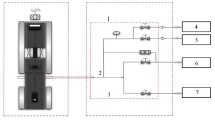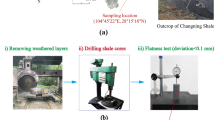Large-scale triaxial physical simulation tests were conducted on Longmaxi Formation shale to identify the fracture network formation mechanism. The extension of the hydraulic fractures was analyzed using a red tracer in the fracturing fluid. The fracturing curve and its relationship with the crack propagation law were determined, and the initiation and expansion of the hydraulic fractures were deduced. The factors that influence the hydraulic fracture propagation law are discussed and the following conclusions were obtained. The hydraulic fractures initiated from the water outlet. During expansion, the hydraulic fractures were subjected to fracture arrest, divarication, penetration or turning, and eventually evolved into a fracture network. The criterion of crack initiation and expansion shows good agreement with the experimental results. The fracture toughness and tensile strength of the shale bedding plane were 49.39% and 31.40% of the shale matrix, respectively, which implies that the bedding planes were sufficiently weak to permit the fractures to more easily steer and divaricate. A fracture network therefore only forms if there are sufficient bedding planes with mechanical properties weaker than those of the shale matrix.
Similar content being viewed by others
References
A. S. Philip, “China's ongoing energy efficiency drive: Origins, progress and prospects,” Energy Policy, 37(4), 1331-1344 (2009).
Z. K. Hou, M. Gutierrez, S. Q. Ma, A. Almrabat, and C. H. Yang, “Mechanical Behavior of Shale at Different Strain Rates,” Rock Mech. Rock Eng., 52(10), 3531-3544 (2019).
Z. K. Hou, H. L. Cheng, S. W. Sun, J. Chen, D. Q. Qi, and Z. B. Liu, “Crack propagation and hydraulic fracturing in different lithologies,” Appl. Geophys., 16(2), 243-251 (2019).
Z. K. Hou, X. W. Li, Y. M. Zhang, H.Q. Liang, Y. Guo, H. L. Cheng, and R. C. Gao, “A Strain Rate Dependent Constitutive Model for the Lower Silurian Longmaxi Formation Shale in the Fuling Gas Field of the Sichuan Basin,China,” Acta Geol. Sin.-Engl., 93(4), 972-981 (2019).
H. Fatahi, M. M. Hossain, and M. Sarmadivaleh, “Numerical and experimental investigation of the interaction of natural and propagated hydraulic fracture,” J. Nat. Gas Sci. Eng., 37, 409-424 (2017).
T. S. Ma, B. S. Wu, J. H. Fu, Q. Zhang, and P. Chen, “Fracture pressure prediction for layered formations with anisotropic rock strengths,” J. Nat. Gas Sci. Eng., 38, 485-503 (2017).
S. C. Zhang, T. K. Guo, T. Zhou, Y. S. Zhou, and S. R. Miao, “Fracture propagation mechanism experiment of hydraulic fracturing in natural shale,” Acta Petrol. Sinica, 35(3), 496-503 (2014).
W. Cheng, Y. Jin, and M. Chen, “Experimental study of step-displacement hydraulic fracturing on naturally fractured shale outcrops,” J. Geophys. Eng., 12(4), 714-723 (2015).
Y. Jin, M Chen, J. Zhou, and Y. Geng, “Experimental study on the effects of salutatory barrier on hydraulic fracture propagation of cement blocks,” Acta Petrol. Sinica, 29(2), 459-468 (2008).
T. Jiang, J. Zhang, and H. Wu, “Experimental and numerical study on hydraulic fracture propagation in coalbed methane reservoir,” J. Nat. Gas. Sci. Eng., 35, 455-467 (2016).
M. Janiszewski, B. T. Sheng, and M. Rinne, “Simulation of the interactions between hydraulic and natural fractures using a fracture mechanics approach,” J. Rock Mech. Geotech., 11(6), 1138-1150 (2019).
D. Xu, R. L. Hu, W. Gao, and J. G. Xia, “Effects of laminated structure on hydraulic fracture propagation in shale” Petrol. Explor. Dev., 42(4), 573-579 (2015).
J. Q. Deng, C. Lin, Q. Yang, Y. R. Liu, Z. F. Tao, and H. F. Duan, “Investigation of directional hydraulic fracturing based on true tri-axial experiment and finite element modeling,” Comput. Geotech., 75, 28-47 (2016).
B. Haimson and C. Fairhurst, “Initiation and Extension of Hydraulic Fractures in Rocks,” Soci. Petr. Eng. J., 7, 310-318 (1967).
M. M. Hossain, M. K. Rahman, and S. S. Rahman, “Hydraulic fracture initiation and propagation: roles of wellbore trajectory, perforation and stress regimes,” J. Petrol. Sci. Eng., 27(3), 129-149 (2000).
Z. K. Hou, C. H. Yang, X. Wei., L. Wang, and H. Wang, “Experimental study on the brittle characteristics of Longmaxi formation shale,” J. China Coal Soc., 41(05), 1188-1196 (2016).
Z. K. Hou, C. H. Yang, L. Wang, P. J. Liu, and Z. Li, “Hydraulic fracture propagation of shale horizontal well by largescale true triaxial physical simulation test,” Rock Soil Mech., 37(2), 407-414 (2016).
Z. K. Hou, M. Gutierrez, A.M. Wang, A. Almrabat, and C. H. Yang, “Mechanical properties and brittleness of shale with different degrees of fracturing-fluid saturation,” Curr. Sci., 09(115), 1163-1174 (2018).
B. Mahanta, A. Tripathy, V. Vishal, T. N. Singh, and P. G. Ranjith, “Effects of strain rate on fracture toughness and energy release rate of gas shales,” Eng. Geol., 218, 39-49 (2016).
G. R. Irwin, “Analysis of Stress and Strains Near the End of a Crack Traversing a Plate,” Int. J. Appl. Mech., 24, 361-369 (1957).
Author information
Authors and Affiliations
Corresponding author
Additional information
Translated from Osnovaniya, Fundamenty i Mekhanika Gruntov, No. 6, November-December, 2021.
Rights and permissions
About this article
Cite this article
Hou, Z., Guo, Y., Liang, S. et al. Shale Gas Stimulation Technology: Large-Scale Triaxial Physical Simulation Tests on Longmaxi Formation Shale. Soil Mech Found Eng 58, 491–499 (2022). https://doi.org/10.1007/s11204-022-09771-1
Published:
Issue Date:
DOI: https://doi.org/10.1007/s11204-022-09771-1




